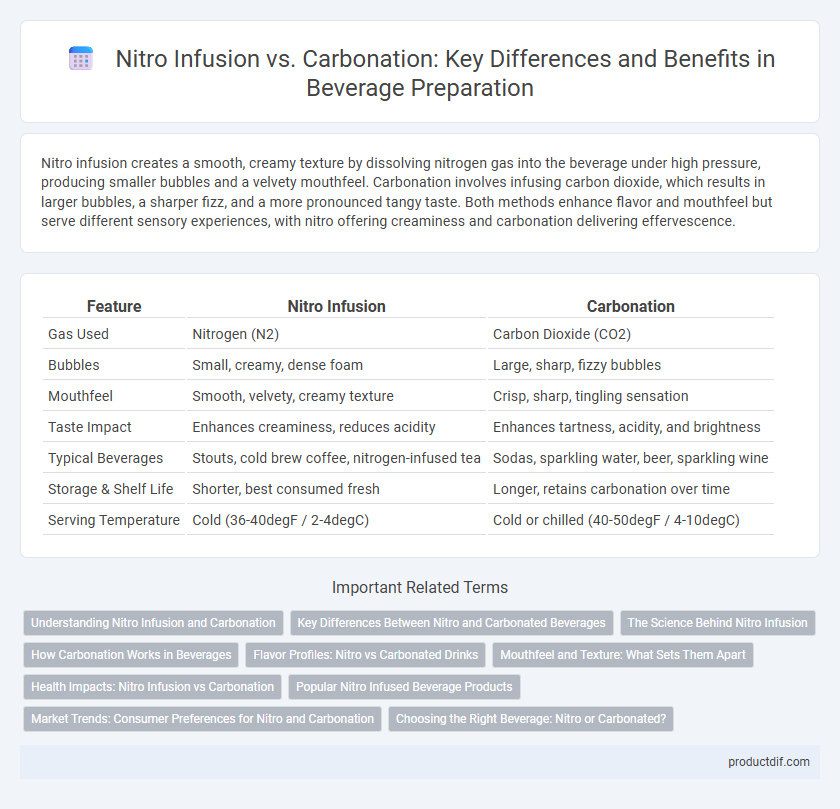Nitro infusion creates a smooth, creamy texture by dissolving nitrogen gas into the beverage under high pressure, producing smaller bubbles and a velvety mouthfeel. Carbonation involves infusing carbon dioxide, which results in larger bubbles, a sharper fizz, and a more pronounced tangy taste. Both methods enhance flavor and mouthfeel but serve different sensory experiences, with nitro offering creaminess and carbonation delivering effervescence.
Table of Comparison
| Feature | Nitro Infusion | Carbonation |
|---|---|---|
| Gas Used | Nitrogen (N2) | Carbon Dioxide (CO2) |
| Bubbles | Small, creamy, dense foam | Large, sharp, fizzy bubbles |
| Mouthfeel | Smooth, velvety, creamy texture | Crisp, sharp, tingling sensation |
| Taste Impact | Enhances creaminess, reduces acidity | Enhances tartness, acidity, and brightness |
| Typical Beverages | Stouts, cold brew coffee, nitrogen-infused tea | Sodas, sparkling water, beer, sparkling wine |
| Storage & Shelf Life | Shorter, best consumed fresh | Longer, retains carbonation over time |
| Serving Temperature | Cold (36-40degF / 2-4degC) | Cold or chilled (40-50degF / 4-10degC) |
Understanding Nitro Infusion and Carbonation
Nitro infusion involves dissolving nitrogen gas into beverages, creating a smooth, creamy texture with tiny bubbles, commonly used in coffee and stouts to enhance mouthfeel and reduce acidity. Carbonation, on the other hand, infuses carbon dioxide, producing sharp, effervescent bubbles that add crispness and a refreshing sensation, widely applied in sodas and sparkling waters. Understanding the distinct gas properties and their effects on flavor, texture, and sensory experience is essential for selecting the ideal infusion method in beverage production.
Key Differences Between Nitro and Carbonated Beverages
Nitro infusion uses nitrogen gas to create smaller, denser bubbles, resulting in a creamier texture and smoother mouthfeel, whereas carbonation relies on carbon dioxide to produce larger, crisp bubbles that give a sharper, more acidic taste. Nitro beverages typically have a cascading visual effect and a thicker head, enhancing sensory appeal compared to the fizzy and effervescent experience of carbonated drinks. The lower acidity and reduced carbonation pressure in nitro drinks often make them less harsh on the stomach than traditional carbonated beverages.
The Science Behind Nitro Infusion
Nitro infusion uses pressurized nitrogen gas to create smaller, stable bubbles that give beverages a smooth, creamy texture and enhance mouthfeel, unlike carbonation which relies on dissolved carbon dioxide to produce larger, fizzy bubbles. The science behind nitro infusion involves nitrogen's lower solubility in liquid compared to CO2, resulting in a cascading visual effect and a less acidic taste profile. This process fundamentally alters the sensory experience by reducing bitterness and increasing perceived sweetness in beverages.
How Carbonation Works in Beverages
Carbonation in beverages occurs when carbon dioxide gas is dissolved under pressure, creating effervescent bubbles upon release. The carbon dioxide molecules form carbonic acid when combined with water, which provides a slight tangy taste and enhances the sensory experience. This process improves the texture, mouthfeel, and overall refreshment qualities of soda, sparkling water, and beer.
Flavor Profiles: Nitro vs Carbonated Drinks
Nitro infusion creates a smoother, creamier texture with subtle sweetness and reduced acidity, enhancing flavor depth without sharp bubbles. Carbonated drinks offer a crisp, effervescent bite that intensifies acidity and brightness, making flavors more pronounced and refreshing. Flavor profiles of nitro versus carbonated beverages differ significantly due to varying gas dissolution and bubble size, impacting mouthfeel and taste perception.
Mouthfeel and Texture: What Sets Them Apart
Nitro infusion creates a creamy, smooth mouthfeel by introducing fine nitrogen bubbles that produce a velvety texture distinct from the sharp, fizzy sensation of carbonation, which uses carbon dioxide to deliver pronounced bubbles and a tingling bite. The smaller nitrogen bubbles in nitro beverages result in a thicker, richer body, enhancing the sensory experience compared to the lighter, more effervescent texture of carbonated drinks. This difference in gas infusion fundamentally alters the perception of texture, making nitro beverages uniquely indulgent and carbonation preferred for refreshing crispness.
Health Impacts: Nitro Infusion vs Carbonation
Nitro infusion in beverages introduces nitrogen gas, resulting in a smoother texture and lower acidity compared to carbonation, which uses carbon dioxide and often increases acidity levels that may irritate the stomach lining. Nitrogen-infused drinks typically contain fewer bubbles and less dissolved gas, reducing bloating and discomfort often associated with carbonated beverages. Health-conscious consumers seeking less acidic and gentler options may prefer nitro-infused drinks over traditional carbonated sodas or beers.
Popular Nitro Infused Beverage Products
Nitro infusion in beverages, popularized by products such as Nitro Cold Brew coffee and Nitro Stout beers, offers a smooth, creamy texture with tiny nitrogen bubbles that enhance mouthfeel without the sharpness of carbonation. Unlike traditional carbonation, which uses carbon dioxide to create a fizzy and acidic sensation found in sodas and sparkling waters, nitro infusion delivers a velvety foam layer and richer flavor profile. Leading brands like Guinness Nitro Stout and Starbucks Nitro Cold Brew capitalize on nitrogen's unique properties to differentiate their products in the competitive beverage market.
Market Trends: Consumer Preferences for Nitro and Carbonation
Consumer preferences in the beverage market increasingly favor nitro infusion for its smooth texture and rich mouthfeel, appealing to craft coffee and specialty beer segments. Carbonation remains dominant in soda and sparkling water categories due to its refreshing, fizzy sensation and widespread consumer familiarity. Market trends indicate a growing demand for nitro beverages among younger, health-conscious consumers seeking unique sensory experiences beyond traditional carbonation.
Choosing the Right Beverage: Nitro or Carbonated?
Nitro infusion creates a smooth, creamy texture with smaller bubbles and a rich mouthfeel, ideal for coffee, stouts, and cold brews. Carbonation offers a crisp, effervescent sensation with larger bubbles, enhancing the freshness and bite in sodas, sparkling waters, and lagers. Selecting between nitro or carbonated depends on desired flavor profile, mouthfeel, and beverage type, ensuring the right sensory experience.
Nitro Infusion vs Carbonation Infographic

 productdif.com
productdif.com